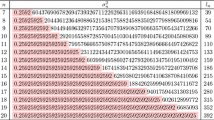Abstract
When performing asymptotic expansions using the strategy of expansion by regions, it is a non-trivial task to find the relevant regions. The recently published Mathematica code asy.m automates this task, but it has not been able to detect potential regions in threshold expansions or Glauber regions. In this work we present an algorithm and its implementation in the update asy2.m which also reveals potential and Glauber regions automatically.

Similar content being viewed by others
Notes
The function UF[] from UF.m [16] is called with three arguments: The list of loop momenta, the list of denominators of the propagators and a list of replacement rules for all kinematic invariants. The output is a list with the following entries: the function \(\mathcal {U}\), the function \(\mathcal {F}\) and the number of loops. In order to obtain \(\mathcal {U}\) and \(\mathcal {F}\) with the correct sign, denominators have to be specified with the opposite sign as in (2), i.e. corresponding to a negative imaginary part −i0: UF[{k1,k2,...}, {-E1,-E2,...}, {replacement rules}].
See e.g. the discussion in Sect. 3.4 of [17].
The name of the command refers to its application to parametric integrals contributing to Wilson loops.
To see this, multiply the integrand of (36) by 1 in the form \(x_{j} \int_{0}^{\infty} \mbox {d}t \, e^{-t x_{j}}\), where x j is any of the integration parameters. Then, inside the t-integration, transform the integration variables as x i →x i /t, i=1,…,N, and use the homogeneity relation (37) with λ=1/t. Finally evaluate the t-integration first, yielding \(\int_{0}^{\infty} \mbox {d}t \,\delta(\sum_{i=1}^{N} a_{i} x_{i} - t) = 1\), independent of the coefficients a i , as long as the linear combination is positive. The integral (36) is given by \(\int_{0}^{\infty}\cdots \int_{0}^{\infty} \mbox {d}x_{1}\cdots \mbox {d}x_{N} \, f(x_{1},\ldots,x_{N}) \, x_{j} \,e^{-x_{j}}\).
References
K.G. Chetyrkin, Theor. Math. Phys. 75, 346 (1988) [Teor. Mat. Fiz. 75, 26 (1988)]
K.G. Chetyrkin, Theor. Math. Phys. 76, 809 (1988) [Teor. Mat. Fiz. 76, 207 (1988)]
S.G. Gorishny, Nucl. Phys. B 319, 633 (1989)
V.A. Smirnov, Commun. Math. Phys. 134, 109 (1990)
V.A. Smirnov, Mod. Phys. Lett. A 10, 1485 (1995)
V.A. Smirnov, Applied Asymptotic Expansions in Momenta and Masses, Springer Tracts in Modern Physics, vol. 177 (Springer, Berlin, 2002)
T. Seidensticker, arXiv:hep-ph/9905298
R. Harlander, T. Seidensticker, M. Steinhauser, Phys. Lett. B 426, 125 (1998)
M. Beneke, V.A. Smirnov, Nucl. Phys. B 522, 321 (1998)
V.A. Smirnov, E.R. Rakhmetov, Theor. Math. Phys. 120, 870 (1999) [Teor. Mat. Fiz. 120, 64 (1999)]
V.A. Smirnov, Phys. Lett. B 465, 226 (1999)
B. Jantzen, J. High Energy Phys. 12, 076 (2011)
A.V. Smirnov, V.A. Smirnov, M. Tentyukov, Comput. Phys. Commun. 182, 790 (2011)
A.V. Smirnov, M.N. Tentyukov, Comput. Phys. Commun. 180, 735 (2009)
A. Pak, A. Smirnov, Eur. Phys. J. C 71, 1626 (2011)
A.V. Smirnov, http://science.sander.su/Tools-UF.htm
V.A. Smirnov, Feynman Integral Calculus (Springer, Berlin, 2006)
http://www-ttp.particle.uni-karlsruhe.de/~asmirnov/Tools-Regions.htm
Acknowledgements
This work is supported by the Deutsche Forschungsgemeinschaft Sonderforschungsbereich/Transregio 9 “Computergestützte Theoretische Teilchenphysik”. The work of A.S. and V.S. is also supported by the Russian Foundation for Basic Research through grant 11-02-01196. The authors thank M. Beneke and A. Pak for helpful discussions.
Author information
Authors and Affiliations
Corresponding author
Rights and permissions
About this article
Cite this article
Jantzen, B., Smirnov, A.V. & Smirnov, V.A. Expansion by regions: revealing potential and Glauber regions automatically. Eur. Phys. J. C 72, 2139 (2012). https://doi.org/10.1140/epjc/s10052-012-2139-2
Received:
Revised:
Published:
DOI: https://doi.org/10.1140/epjc/s10052-012-2139-2




